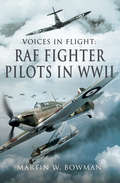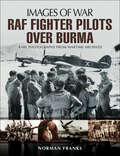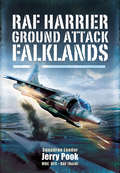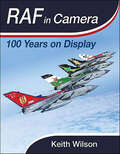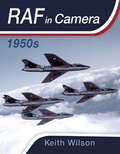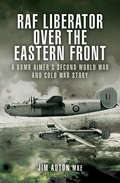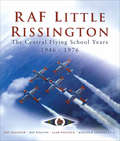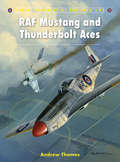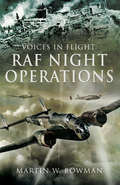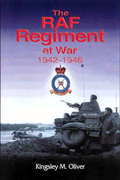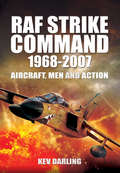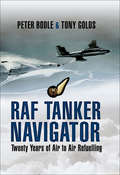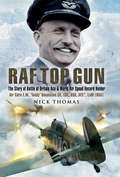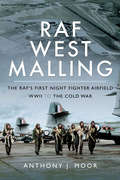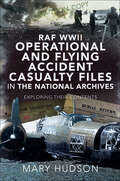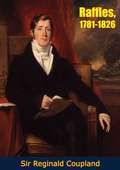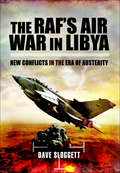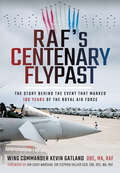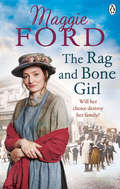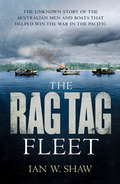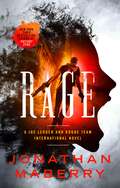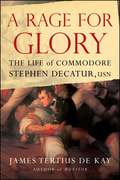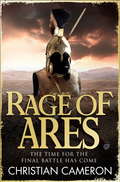- Table View
- List View
RAF Fighter Pilots in WWII
by Martin W. BowmanThis is a pulsating account of the young RAF fighter boys who flew Spitfires, Hurricanes and Defiants in England against the Luftwaffe and from Malta 1940-45 against the Regia Aeronautica. Their story is told using combat reports and first person accounts from RAF, German and Commonwealth pilots who fought in the skies in France in 1940, in England during the Battle of Britain, and in the great air offensives over Occupied Europe from 1942 onwards. Chapters include the stories of Wing Commander D. R. S. Bader, Wing Commander Adolph Gysbert 'Sailor' Malan, Oberleutnant Ulrich Steinhilper, Flight Lieutenant H. M. Stephen, Squadron Leader Robert Stanford Tuck, 'Johnny' Johnson, Squadron Leader M. N. Crossley, Squadron Leader A. McKellar, 'Cowboy' Blatchford and Squadron Leader D. H. Smith, an Australian veteran of the Battle of Malta and many others whose names have now become legendary.
RAF Fighter Pilots Over Burma: Rare Photographs From Wartime Archives (Images of War)
by Norman FranksIt is a recognized fact that, had the war gone badly for the Allies on the India/Burma front, and had the Japanese succeeded in invading the Indian Continent, the outcome of the war would have been entirely different. Yet despite this, the campaign on the Burma front is offered surprisingly scant coverage in the majority of photo-history books. This new book, from respected military historian and author Norman Franks, attempts to redress the balance, noting the importance of this particular aerial conflict within the wider context of the Second World War.Franks takes as his focus the pilots, aircraft and landscapes that characterized the campaign. Photographs acquired during the course of an intensive research period are consolidated into a volume that is sure to make for a popular addition to the established Images of War series. Many unpublished photographs feature, each one offering a new insight into the conflict as it unfolded over Burmese skies. The archive offers a wealth of dynamic images of RAF Hurricanes and Spitfires in flight, with shots of both the aircraft and the pilots employed during this challenging conflict. To fly and fight in Burma, pilots really had to be at the top of their game. The Japanese enemy certainly weren't the only problem to contend with; weather, poor food, incredible heat and all its attendant maladies, jungle diseases, tigers, elephants, fevers... The Japanese were the real enemy but the British pilots had so much more to deal with. And they did it for years. In Britain, a pilot could look forward to a break from operations every six months or so on average. In Burma, pilots first employed in 1941 were still flying operations in 1944. The collection represents a determination on the author's part to record the part played by these resilient and skilled RAF fighter pilots, the contribution that they paid in supporting General Slim's 14th Army and the part they ultimately played in defeating the Japanese attempts to break through into India. These efforts, all paramount and imperative to success, are celebrated here in words and images in a volume sure to appeal to Spitfire and Hurricane enthusiasts, as well as the more general reader.
RAF Harrier Ground Attack: Falklands
by Jerry PookAn &“interesting and highly informative personal memoir . . . a much-needed addition to the body of work covering the air war over the Falklands.&”—IPMS/USA During the Falklands War, Jerry Pook, a pilot in No. 1(F) Squadron RAF, flew air interdiction, armed reccon, close-air-support and airfield attack as well as pure photo-reccon missions. Most weapons were delivered from extreme low-level attacks because of the lack of navigation aids and in the absence of Smart weapons. The only way he could achieve results was to get low down and close-in to the targets and, if necessary, carry out re-attacks to destroy high-value targets. Apart from brief carrier trials carried out many years previously, there had been no RAF Harriers deployed at sea. The RAF pilots were treated with ill-disguised contempt by their naval masters, their professional opinions ignored in spite of the fact that the RN knew next to nothing about ground-attack and reccon operations. Very soon after starting operations from the aircraft carrier HMS Hermes, the squadron realized that they were considered as more or less expendable ordnance. The Harriers lacked the most basic self-protection aids and were up against 10,000 well-armed troops who put up an impressive weight of fire whenever attacked. &“Prior to this book, very little had been written in detail describing the RAF Harrier GR3 operations during the 1982 Falklands War. This book fills that void very well, providing a wealth of detail in describing the lead up, deployment and day-to-day combat operations of the small contingent of Royal Air Force attack Harriers.&”—IPMS/USA
RAF in Camera: 100 Years on Display
by Keith WilsonIn July 2018, the nation looked skyward over Buckingham Palace in awe as the Royal Air Force celebrated its first 100 years with a spectacular parade and flypast over London. This event demonstrated a very different perspective of the RAF; well away from its operational commitments. The expertise and precision of those RAF pilots flying in some of the most famous aircraft in the world has been displayed since the very first days of military aviation. The Inter-War period was dominated by the Hendon Air Pageants; where many aircraft made their public appearance. Post-war, it was the turn of the jet display teams, with the Black Arrows and Firebirds’ laying the foundations for the aerial mastery that is today’s Red Arrows. The various anniversaries have seen a growth in special artwork being applied to aircraft flown by squadrons celebrating key anniversaries. This is covered in considerable detail within this volume. On the ground, the RAF is represented at major celebrations and key public events by the Queen’s Colour Squadron, which demonstrates its world-famous continuity drill routine while providing a guard of honor for visiting Heads of States. They are frequently accompanied with the Service’s own bands; which have grown from those created by its squadrons over a century ago. From the Berlin Airlift in 1948; to flood relief in Kenya; and the international relief effort in the Caribbean following Hurricane Irma in 2017; the RAF has been deployed overseas in response to numerous international crises. But aid operations have also been mounted at home. Under the banner of ‘Military Aid to the Civil Powers’, helicopters and aircraft have airlifted food and supplies to areas cut off by severe weather; Sea King helicopters have rescued villagers stranded by flash flooding in Boscastle; while Chinook helicopters have assisted with the rebuilding of flood defenses breached by severe floods across the country. The golden age of record-breaking also features in this book. From long-range flights to South Africa and Australia; the Schneider Trophy triumph; speed records in the jet age; along with altitude records with pilots in special pressure suits; the RAF has demonstrated its reputation as a truly pioneering Air Arm. Keith Wilson takes us on a journey through the Royal Air Force’s public persona during their 100 year history. All landmark events are referenced in this thorough, well-researched and image-packed publication. As with the three previous releases, this new addition to the In Camera series is sure to be regarded as something of a collector’s edition and a real enthusiast’s favorite.
RAF in Camera: 1950s
by Keith WilsonThis photographic record of the RAF during the 1950s looks set to appear widely. Featuring varied and dynamic visual representation throughout, the events of this important decade are enlivened to great effect. The 1950s was a pivotal decade in aviation for many reasons. The RAF were employed in a great number of post-WWII roles, and the beginning of the Cold War saw many advances in the field of developmental aviation. The early years of the decade saw the Coronation of HRH Queen Elizabeth II take place, and a variety of photographs taken at the Queen's Review flypast at RAF Oldham on the 15 July 1953 are arrayed here. Meteors, Sabres, Chipmunks, Canberras, Vulcans... the list goes on. A wide selection of action shots illustrate the impressive aesthetics of some of these aircraft in formation. Shots of aircraft utilised during the course of the Cold War also feature, as do highly intriguing photographs of the Thor Intermediate Range Ballistic Missiles, stored on Bomber Command bases towards the end of the decade. Each chapter focusses on a specific year, relaying all the most fascinating highlights. This is a colourful, insightful and image-packed history, told with narrative flair and a clear passion for the subject matter at hand.
RAF Liberator over the Eastern Front: A Bomb Aimer's Second World War and Cold War Story
by Jim AutonJim Auton was posted to 178 Squadron who were operating ex-U.S.A.A.F., war-weary Liberator heavy bombers. This squadron he was based in Foggia in Italy, living under canvas without the barest of military or personal necessities. The duration of a tour at that time was 40 front-line operations over such dangerous targets as Ploesti and the Danube few in the squadron felt they could survive since the casualty rate was so high. Then came his part in the desperate attempts to supply the besieged city of Warsaw when the Liberators were ordered to fly in at 500 feet, at their lowest speed and with flaps and undercarriage down, to drop desperately needed ammunition and supplies. All this through a hail of both German and Russian gunfire. On his 37th sortie Jim, aged twenty, was severely wounded when he was hit by Flak whilst is in his bomb-aimers position in the aircrafts nose.
RAF Little Rissington: The Central Flying School, 1946–76
by Roy Bagshaw Alan Pollock Malcolm Thomas Ray DeaconIn the three decades between 1946 and 1976, the Central Flying School which was based at Little Rissington, produced over 6000 fledgling Qualified Flying Instructors and continually endeavoured to monitor and improve the wider Royal Air Force's standards of flying, based on its sound, proven instructional methods and a wealth of tradition extending back to Upavon in 1912. With the cessation of hostilities in 1945, the station's role took on a new dimension with the arrival of the Central Flying School (CFS) from RAF Upavon in the following year. The main function of CFS was to fulfil RAF requirements and assist some Commonwealth air force requirements for flying instructors. RAF Little Rissington became CFS's important focal base for the next thirty years. The book covers the 1946 to 1976 period and has been drawn from from the records at the National Archives, the RAF Museum, the Central Flying School Archive, and from published sources. Anecdotes and recollections from over 100 service and civilian personnel, ranging from Air Marshals to AC2s, who were once based at Little Rissington bring these unfolding years to life.
RAF Mustang and Thunderbolt Aces
by Chris Davey Andrew ThomasThe P-51 Mustang and P-47 Thunderbolt were the finest American fighters of World War 2, and both saw service with the Royal Air Force in substantial numbers. The RAF began flying the Mustang in 1944, using it to fly bomber escort missions, and deploying to support the ground campaigns in Italy and the Balkans. It was also flown by a number of Polish units in the RAF. The P-47 Thunderbolt was the best fighter available in CBI theater, where it was flown by a number of aces against the Japanese, mainly in a ground support role. Although these two fighter types are most associated with the Americans, they performed an important role serving in the RAF.
RAF Night Operations: Raf Night Operations (Voices in Flight)
by Martin W. Bowman'The Navy can lose us the war, but only the Air Force can win it. Therefore our supreme effort must be to gain overwhelming mastery in the air. The Fighters are our salvation but the Bombers alone provide the means of victory...' So said Prime Minister Winston Churchill to the War Cabinet on the first anniversary of the outbreak of war. But when Britain declared war on Germany in September 1939 her bombers were predominantly twin-engined types like the Wellington, Whitley and the Hampden which after suffering carnage during the day were soon switched to night operations.Wartime speeches alone cannot begin to describe the misery and fortitude, desperation and terror endured by the civilian population during the 'Blitz Nights' in Coventry, the London docklands and the East End as night after night bombs and incendiaries rained down on them. Their personal experiences and those of war correspondents like James Negley Farson are as vivid, poignant and descriptive as those of the bomber crews carrying the war to the enemy in the early night bomber offensive. These too are mostly recounted at first hand, sometimes in BBC broadcasts to the nation; and they include 'The Unanswerable Double'; 'Winged Words'; 'German Defences'; 'Getting Frightened'; 'Jump For It!'; 'The Night The Fuel Ran Out'; 'Flames, Flares and Fires'; 'Busted Flush'; 'The Tail Gunner's Story' and 'Hampden and 'Wimpy' Ops'. They tell just what it was like to fly in a heavy bomber over occupied Europe.
The RAF Regiment at War, 1942–1946
by Kingsley M. OliverBorn out of necessity in the dark days of the War, the RAF Regiment found itself in the thick of the action supporting the vital operations in all theaters. This comprehensive record of their operations gives the clearest indication of the contribution that the Regiment made and includes many first hand accounts of the fighting, including the first shooting-down of a jet aircraft, the Me 262A-2a Sturmvogel in November 1944. As a result of their outstanding contributions to the success of RAF operations in WW2, the Regiment became a permanent part of the RAF. This is the official history of the RAF Regiment from its foundation 60 years ago to the aftermath of hostilities.
RAF Strike Command, 1968–2007: Aircraft, Men and Action
by Kev DarlingAviation author Kev Darling looks at the origins of the World War Two Royal Air Force commands and histories in RAF Strike Command.In 1968, the RAF Commands that had become famous in World War Two—Fighter, Bomber, Coastal, Air Support and Signals Commands—were combined into the single Strike Command, an amalgamation that served throughout the remaining years of the Cold War, in the Falklands, and in the Middle East in Operations Desert Shield, Desert Storm and Granby. This organizational change caused re-equipment, base changes and increasing economic constraints. The Royal Navy was now responsible for the UK’s nuclear deterrent in the form of their Polaris submarines, so the RAF’s V-Bomber Force were now relegated to tanker operations, with the exception of the lone Vulcan that was sent to the Falklands conflict. The Command’s fleet of fast jets became more adaptable, with single types assuming the roles of fighter, bomber, reconnaissance, and maritime attack. The aircraft also became multinational in their design and manufacture as Britain’s postwar lead in aircraft design had been frittered away by years of thoughtless government, leading to a single company for production. Apart from the brilliant Harrier which the US continues to develop and build, other aircraft flown by the Command were from European syndicates, such as the Tornado and Jaguar. The US supplied the transports in the form of the faithful Hercules, and Europe most of the helicopter fleet.Exploring the operations that took place during this military wing’s existence, the aircraft they flew and the men who flew them, RAF Strike Command is a tribute to the fast-dwindling power of the Royal Air Force.
RAF Tanker Navigator
by Peter Bodle Tony GoldsThis book gives a rare insight into the life inside the tanker squadrons of the Royal Air Force, viewed through the eyes of Tony Golds, one of the R.A.F. tanker fleets longest serving Navigator/Plotters. During his service career which spanned four decades, he flew in dozens of airplanes, for literally thousands of hours and covered something in excess of two million miles. Initially the prime role of the first tankers (Valiants) was to service the legendary English Electric Lightning interceptor fighters patrolling the North Sea. During his career, Tony served in every continent of the world, including a healthy series of tours at Ascension just after the Falklands War. He was in one of the tanker crews chosen to assist in devising the procedures needed to get both the Vulcans in the Black Buck operation down to the Falklands, and subsequently the Hercules C130 freighters to form the Ascension / Falklands air bridge, so vital for the support of the Falkland Islands, once the shooting war was over.
RAF Top Gun: The Story of Battle of Britain Ace and World Air Speed Record Holder Air Cdre E.M. 'Teddy' Donaldson CB, CBE, DSO, AFC*, LoM (USA)
by Nick ThomasEdward Teddy Mortlock Donaldson was one of three aviator brothers to win the D.S.O. during World War II. He joined his brother in the R.A.F. and was granted a sort-service commission. He quickly became both a stunt pilot and a crack-shot, winning the R.A.F.s Gunnery Trophy One and leading the R.A.F.s aerobatic display team. When war was declared Donaldson was commanding No 151(F) Squadron flying Hurricanes and in their first engagement destroyed six enemy aircraft, shooting down many more in the following months. For his leadership of the squadron during the battle and his personal tally of eleven, plus ten probable destruction's he was awarded the D.S.O. He then spent three years as a gunnery instructor in the USA where he taught American Gun Instructors and helped set up new gunnery schools. On his return to England he converted onto jet aircraft and commanded a Meteor squadron. This lead to him being selected to command the Air Speed Flight, established in 1946 to break the world record. Teddy eventually snatched the title, setting a new speed record and breaking the 1000 km/h barrier. He retired as an Air Commodore and became the Air Correspondent for the Daily Telegraph. He died in 1992.
RAF West Malling: The RAF's First Night Fighter Airfield, WWII to the Cold War
by Anthony J. Moor&“Inspiring history of the first designated night fighter base . . . an important piece of social and military history . . . a must-read!&” —Books Monthly Anthony J. Moor&’s exhaustively researched and highly illustrated book is the first to tell the full story of the part West Malling played in the defense of the United Kingdom, and how it served the RAF for twenty-eight action-packed years. Opened as a private landing ground after the First World War, the airfield at West Malling became home to the Maidstone School of Flying in 1930. The airfield&’s RAF role came to the fore in June 1940; by then the station had been fitted with a concrete runway. The first aircraft arrived on 8 June 1940. As the UK&’s first designated night fighter base, over the years that followed, RAF West Malling was home to many famous pilots—men such as John Cunningham, Peter Townsend, Bob Braham and even Guy Gibson, later of Dambusters fame. During the summer of 1944, Mosquitoes, Spitfires and Mustang Mk.3s successfully destroyed many V-1s, as well as played their part in the D-Day landings. West Malling&’s strategic night fighter role continued into the Cold War, when No.500 (Kent&’s Own) Squadron adopted it as its home in this period. A US Navy Facility Flight was also based at the airfield in the 1960s. After closure as an operational air station in 1969, West Malling re-acquired its civilian guise, hosting a Gliding School, Short Brothers and several major Great Warbirds Air Displays during the 1970s and 1980s, until eventually closing completely as an airfield, for re-development.
RAF West Malling: The RAF's First Night Fighter Airfield, WWII to the Cold War
by Anthony J. Moor&“Inspiring history of the first designated night fighter base . . . an important piece of social and military history . . . a must-read!&” —Books Monthly Anthony J. Moor&’s exhaustively researched and highly illustrated book is the first to tell the full story of the part West Malling played in the defense of the United Kingdom, and how it served the RAF for twenty-eight action-packed years. Opened as a private landing ground after the First World War, the airfield at West Malling became home to the Maidstone School of Flying in 1930. The airfield&’s RAF role came to the fore in June 1940; by then the station had been fitted with a concrete runway. The first aircraft arrived on 8 June 1940. As the UK&’s first designated night fighter base, over the years that followed, RAF West Malling was home to many famous pilots—men such as John Cunningham, Peter Townsend, Bob Braham and even Guy Gibson, later of Dambusters fame. During the summer of 1944, Mosquitoes, Spitfires and Mustang Mk.3s successfully destroyed many V-1s, as well as played their part in the D-Day landings. West Malling&’s strategic night fighter role continued into the Cold War, when No.500 (Kent&’s Own) Squadron adopted it as its home in this period. A US Navy Facility Flight was also based at the airfield in the 1960s. After closure as an operational air station in 1969, West Malling re-acquired its civilian guise, hosting a Gliding School, Short Brothers and several major Great Warbirds Air Displays during the 1970s and 1980s, until eventually closing completely as an airfield, for re-development.
RAF WWII Operational and Flying Accident Casualty Files in The National Archives: Exploring Their Contents
by Mary Hudson“A journey through the original RAF Casualty Branch files, and all the other available sources of information relating to RAF wartime casualties.” —Military Historical SocietyAt its height during the Second World War, the RAF totaled 185,000 personnel. All information concerning casualties was carefully complied at the Air Ministry and now, from these the official records, those covering operational losses (in the air and on the ground) and flying accidents are being made available to the public through The National Archives.This huge collection of casualty files contains a wealth of contemporary documentation from a variety of sources including captured German records. It includes official documents, examples of which are given, accounts of searches undertaken to establish the fate of the missing, places of burial, copies of information received from the International Red Cross and from sources within enemy occupied lands, as well as letters from family and friends some of which reveal dark secrets of bigamy, adultery, illegitimacy, debt and dishonor.In this groundbreaking book, Mary Hudson has used her expert knowledge to provide an invaluable guide to the understanding of these records for use by researchers and family members alike. “An intriguing work bringing the fruits of many years of inside experience into the hands of those trying to find the missing piece in the jigsaw of a family tree or any RAF historian.” —The Shackleton Association“Fascinating . . . illustrates the dedication of the teams who handled the difficult issues of death and the missing in a very compassionate and dedicated manner.” —Journal of The Orders & Medals Research Society
RAF WWII Operational and Flying Accident Casualty Files in The National Archives: Exploring Their Contents
by Mary Hudson“A journey through the original RAF Casualty Branch files, and all the other available sources of information relating to RAF wartime casualties.” —Military Historical SocietyAt its height during the Second World War, the RAF totaled 185,000 personnel. All information concerning casualties was carefully complied at the Air Ministry and now, from these the official records, those covering operational losses (in the air and on the ground) and flying accidents are being made available to the public through The National Archives.This huge collection of casualty files contains a wealth of contemporary documentation from a variety of sources including captured German records. It includes official documents, examples of which are given, accounts of searches undertaken to establish the fate of the missing, places of burial, copies of information received from the International Red Cross and from sources within enemy occupied lands, as well as letters from family and friends some of which reveal dark secrets of bigamy, adultery, illegitimacy, debt and dishonor.In this groundbreaking book, Mary Hudson has used her expert knowledge to provide an invaluable guide to the understanding of these records for use by researchers and family members alike. “An intriguing work bringing the fruits of many years of inside experience into the hands of those trying to find the missing piece in the jigsaw of a family tree or any RAF historian.” —The Shackleton Association“Fascinating . . . illustrates the dedication of the teams who handled the difficult issues of death and the missing in a very compassionate and dedicated manner.” —Journal of The Orders & Medals Research Society
Raffles, 1781-1826
by Reginald CouplandFirst published in 1926, this is a scholarly work on Sir Thomas Stamford Raffles, FRS (July 6, 1781 - July 5, 1826), a British statesman, Lieutenant-Governor of British Java (1811-1815) and Governor-General of Bencoolen (1817-1822), best known for his founding of Singapore. He was also heavily involved in the conquest of the Indonesian island of Java from Dutch and French military forces during the Napoleonic Wars and contributed to the expansion of the British Empire.
The RAF's Air War In Libya: New Conflicts in the Era of Austerity
by Dave SloggettThe uprising in Libya in the spring of 2011 took the world by surprise. The Gaddafi regimes brutal attempts at suppressing the uprising, however, soon prompted the international community to respond. NATO agreed to impose a no-fly zone across Libya, which was led by Britain, France and the USA.For the British Prime Minister, David Cameron, the deployment of RAF and Royal Navy assets in support of UN Resolution 1973, came at a time when severe cuts to the UKs defense spending were in the process of being enacted. With the Royal Navy aircraft carriers and their Harrier jets no longer available, would the UK be able to mount operations 3,000 miles away?In this, the first book to analyze the Libyan campaign, David Sloggett details the causes of the uprising, and examines each stage of the war through to its termination with the death of Colonel Gaddafi.In conclusion, Dr. Sloggett considers the future prospects for a post-Gaddafi Libya and, more significantly, how NATO in general and Britain in particular, will respond to similar events in the future.
RAF's Centenary Flypast: The Story Behind the Event that Marked 100 Years of the Royal Air Force
by Kevin Lee GatlandOn 10 July 2018, exactly 100 years and 100 days after the formation of the world’s first independent air force, 103 aircraft of twenty-four types from twenty-five squadrons flew over London in the largest formation of military aircraft seen over the capital of the UK in nearly thirty years. Involving over 250 aircrew and operating out of fourteen military and two civilian airfields, with nineteen back-up aircraft and a standby air-to-air refueling tanker, the Royal Air Force put on a unrivaled display to mark the centenary of its creation on 1 April 1918, in the closing months of the First World War. Exemplifying that long and proud history, was the Spitfire, Hurricane, Lancaster and Dakota of the Memorial Flight, as well as the enduring Hercules, with the newly acquired F-35B Lightning displaying the RAF’s continuing global importance. This book reveals how the flypast was conceived and examines the detailed planning involved in the event, written by someone who would know – the project manager and coordinator. The composition and size of the flypast was truly momentous, comprising virtually every type of aircraft that the RAF operated at the time. As Chief of Staff at the Tornado GR4 Force Headquarters operating from RAF Marham, and an experienced Tornado GR4 Navigator, Wing Commander Kevin Gatland had the task of pulling together all the necessary components, both military and civilian required to produce an unrivaled aerial display. This involved considering the feasibility of assembling so many varied types of aircraft, all with different speeds and capabilities, in addition to concentrating them into a tight schedule to produce a virtually continuous stream of aircraft over central London, with elements breaking off to pass over the northerly runway at Heathrow Airport, the RAF Memorial at Runnymede, Windsor Castle and the RAF Museum at Hendon. Beautifully illustrated with glorious color in-flight photographs of the magnificent aircraft of the current RAF as well as the briefing and planning session, this book demonstrates the enormous range of factors that had to be taken into consideration to produce the amazing spectacle that was witnessed by the Queen from Buckingham Palace and the thousands who gathered in The Mall – an event captured in the pages of this fascinating book.
The Rag and Bone Girl
by Maggie FordWhat will she sacrifice for love? Growing up in London’s East End with six siblings, Nora Taylor has always been close to her younger sister Maggie. But when she meets Maggie’s fiancé Robert, they are immediately drawn to each other. Forced to choose between her family and her heart, Nora decides to marry the man she loves – even if it means losing her sister.When the First World War breaks out, Nora must fight to hold her family together through the challenges and tragedies to come. As her children grow up they embark on their own adventures, but another war will threaten all their hopes for the future. Can this broken family survive the dark days of wartime?A sweeping saga charting one family’s fortunes through the First and Second World War and beyond, perfect for fans of Maggie Hope and Dilly Court.
The Rag Tag Fleet: The unknown story of the Australian men and boats that helped win the war in the Pacific
by Ian W. ShawThe fascinating - and unknown - story of the Rag Tag Fleet, a collection of hundreds of Australian fishing trawlers and schooners, organised by the US Army, which transported vital supplies for US and Australian forces across the South-East Pacific.Boys under the age of 17 and men over 60, and those who weren't well enough to join the Australian regular forces formed the crews. Each boat was armed with one machine gun - and sailed under the American flag.Conditions on the boats were grim. Numerous crew members contracted diseases including malaria, dysentery and dengue fever. Vulnerable to aircraft attack, the boats were frequently strafed and bombed.The story is told through the experiences of the Australian crew on half a dozen ships - including Jack Savage, boat builder extraordinaire; Ray Parer, air fighter, explorer and gold miner; and Norm Oddy, bandleader, drifter and mechanic.The focus of THE RAG TAG FLEET is the unknown story of the final months of 1942, when these men ran the gauntlet of Japanese air attacks, reefs and shallow, shark-infested waters to bring in the supplies and equipment for the US and Australian troops that defeated the entrenched Japanese forces at Buna on the PNG coast, and so helped turn the course of the war.
Rage: A Joe Ledger and Rogue Team International Novel (Rogue Team International Series #1)
by Jonathan MaberryFrom New York Times Bestselling author (creator of the Netflix series V Wars), Jonathan Maberry comes the first in a brand new series featuring Joe Ledger and Rogue Team International. A small island off the coast of Korea is torn apart by a bioweapon that drives everyone—men, women, and children—insane with murderous rage. The people behind the attack want Korea reunified or destroyed. No middle ground. No mercy. Soon Japan, China, and the United States are pushed to the brink of war, while terrorists threaten to release the rage bioweapon in a way of pure destructive slaughter. Joe Ledger leads his newly formed band of international troubleshooters in their first mission to stop the terror cell, fighting alongside agents from North and South Korea. With the lives of billions at stake, Ledger is willing to bring his own brand of terror to this frightening new war.
A Rage for Glory
by James Tertius de KayStephen Decatur was one of the most awe-inspiring officers of the entire Age of Fighting Sail. A real-life American naval hero in the early nineteenth century, he led an astonishing life, and his remarkable acts of courage in combat made him one of the most celebrated figures of his era. Decatur's dazzling exploits in the Barbary Wars propelled him to national prominence at the age of twenty-five. His dramatic capture of HMSMacedonianin the War of 1812, and his subsequent naval and diplomatic triumphs ...
Rage of Ares (The Long War)
by Christian CameronArimnestos of Plataea was one of the heroes of the Battle of Marathon, in which the heroic Greeks halted the invading Persians in their tracks, and fought in the equally celebrated naval battle at Salamis.But even these stunning victories only served to buy the Greeks time, as the Persians gathered a new army, returning with overwhelming force to strike the final killing blow.For the Greeks, divided and outnumbered, there was only one possible strategy: attack. And so, in the blazing summer of 479 BC, Arimnestos took up his spear one final time at the Battle of Plataea.
